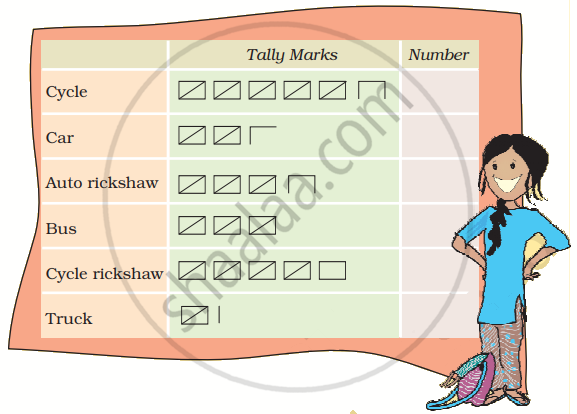Advertisements
Advertisements
प्रश्न
Construct a frequency table with equal class intervals from the following data on the monthly wages (in rupees) of 28 labourers working in a factory, taking one of the class intervals as 210-230 (230 not included):
220, 268, 258, 242, 210, 268, 272, 242, 311, 290, 300, 320, 319, 304, 302, 318, 306, 292, 254, 278, 210, 240, 280, 316, 306, 215, 256, 236.
उत्तर
The frequency table of the monthly wages of 28 labourers working in a factory is given below:
| Wage | Tally Marks | Frequency |
| 210-230 | |||| | 4 |
| 230-250 | |||| | 4 |
| 250-270 | 5 | |
| 270-290 | ||| | 3 |
| 290-310 | 7 | |
| 310-330 | 5 |
APPEARS IN
संबंधित प्रश्न
Define the following term:
Discrete frequency distribution
The weights of new born babies (in kg) in a hospital on a particular day are as follows:
2.3, 2.2, 2.1, 2.7, 2.6, 3.0, 2.5, 2.9, 2.8, 3.1, 2.5, 2.8, 2.7, 2.9, 2.4
(i) Rearrange the weights in descending order.
(ii) Determine the highest weight.
(iii) Determine the lowest weight.
(iv) Determine the range.
(v) How many babies were born on that day?
(vi) How many babies weigh below 2.5 kg?
(vii) How many babies weigh more than 2.8 kg?
(viii) How many babies weigh 2.8 kg?
Following data gives the number of children in 40 families:
1, 2, 6, 5, 1, 5, 1, 3, 2, 6, 2, 3, 4, 2, 0, 0, 4, 4, 3, 2, 2, 0, 0, 1, 2, 2, 4, 3, 2, 1, 0, 5, 1, 2, 4, 3, 4, 1, 6, 2, 2.
Represent it in the form of a frequency distribution.
Following figures relate to the weekly wages (in Rs) of 15 workers in a factory:
300, 250, 200, 250, 200, 150, 350, 200, 250, 200, 150, 300, 150, 200, 250
Prepare a frequency table.
(i) What is the range in wages (in Rs)?
(ii) How many workers are getting Rs 350?
(iii) How many workers are getting the minimum wages?
Construct a frequency table for the following weights (in gm) of 35 mangoes using the equal class intervals, one of them is 40-50 (45 not included):
30, 40, 45, 32, 43, 50, 55, 62, 70, 70, 61, 62, 53, 52, 50, 42, 35, 37, 53, 55, 65, 70, 73, 74, 45, 46, 58, 59, 60, 62, 74, 34, 35, 70, 68.
(i) What is the class mark of the class interval 40-45?
(ii) What is the range of the above weights?
(iii) How many classes are there?
The daily minimum temperatures in degrees Celsius recorded in a certain Arctic region are as follows:
−12.5, −10.8, −18.6, −8.4, −10.8, −4.2, −4.8, −6.7, −13.2, −11.8, −2.3, 1.2, 2.6, 0, −2.4, 0, 3.2, 2.7, 3.4, 0, −2.4, −2.4, 0, 3.2, 2.7, 3.4, 0, −2.4, −5.8, −8.9, −14.6, −12.3, −11.5, −7.8, −2.9
Represent them as frequency distribution table taking − 19.9 to − 15 as the first class interval.
Viji threw a die 30 times and noted down the result each time as follows. Prepare a table on the numbers shown using Tally Marks.
| 1 | 4 | 3 | 5 | 5 | 6 | 6 | 4 | 3 | 5 | 4 | 5 | 6 | 5 | 2 |
| 4 | 2 | 6 | 5 | 5 | 6 | 6 | 4 | 5 | 6 | 6 | 5 | 4 | 1 | 1 |
The table shows the number of calls recorded by a Fire Service Station in one year.
| Types of Calls | Tally Marks | Frequency |
| Building Fires | |||| | | |
| Other Fires | |||| |||| | | |
| Hazardous Materials | 7 | |
| Rescues | 4 | |
| False Alarms | |||| || | |
| Total | ||
Complete the table and answer the following questions.
(i) Which type of call was recorded the most?
(ii) Which type of call was recorded the least?
(iii) How many calls were recorded in all?
(iv) How many calls were recorded as False Alarms?
Sumita stood on the road for half an hour and counted the number of vehicles passing by. She made a tally mark for each vehicle. This helped her in counting the total number of vehicles in each group.

- Write the number of each vehicle in the table.
- How many vehicles in all did Sumita see on the road in half an hour?
- Auto rickshaws are thrice the number of trucks — true/false?
- Make tally marks for 7 more buses and 2 more trucks.
An observation occurring seven times in a data is represented as ______ using tally marks.
